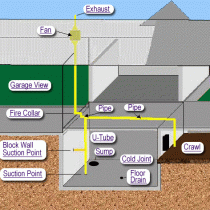HUD Multifamily Radon Testing Protocols: Why you have to test on every Floor of a Building By: Jessica Karns

I was recently asked by a client “If radon comes from the ground why do you have to test for it on every level of the building?”
To many, this HUD requirement must seem like a very unnecessary and expensive task added to the radon testing protocol of a multifamily building. As a licensed radon tester, I can assure you that testing on every levels of a multifamily building is very necessary.
My client was correct in his thinking that radon comes from the ground. In fact, radon comes from a decay of uranium which is found in the soil in various concentrations across the US. As Uranium goes through its decay cycle, it eventually turns into radon gas. Radon is a radioactive gas that is the leading cause of lung cancer amongst non-smokers. Radon will attach itself to oxygen atoms. We breathe this combination into our lungs and eventually this can lead to adverse health effects.
There are two ways radon enters our breathable air: as part of soil air influx into the building and a process called building emanation.
Soil air influx is the pathway we traditional way we think about radon getting into a building. The radon in the soil simply diffuses into the indoor air via the path of least resistance.
Building emanation sometimes referred to as contaminated building materials, is much more complex. The radon source here isn’t in the soil, it is actually the materials themselves. Things like concrete and stone countertops contain materials we mine out of the ground. In some cases these materials contain large enough amounts of radioactive material that they effect the radon levels in a room. Since this source is not connected with the soil, it can happen on any floor.
These two pathways require different mitigation strategies as well. A traditional sub slab depressurization system will not affect the radon levels caused by building emanation.
When we test a building for radon we must ensure the safety of the residents on all of the floors, not just the ground floor.
Other natural materials like slate, stone or granite can also contain uranium and have a potential for emanating radon gas. There are techniques to determine the source of radon if it is not coming from the ground level but the initial HUD protocol test must be done as a first step in the process.
Once determined to be radon from building emanation, there are a few options for remediation. Systems can be designed and installed to dilute the radon concentration by bringing in fresh air. Another option would be to remove the source of emanation. Either way a radon contractor should be able to source the radon and design a plan to reduce the radon levels below the EPA action level.
About the Author
Jessica Karns joined A-Z Radon Services in 2011 as the Sales & Marketing Manager. A seasoned professional, she has acquired over 10 years of experience in the sales and marketing arena. In her current position, Jessica is responsible for designing and overseeing the strategic direction of the companies’ marketing plan including web site design, social media content and media relations.
In addition, Jessica is a state licensed radon testing professional. Jessica also holds a radon testing certification through the NRPP (National Radon Proficiency Program.). She heads up the companies’ continuing education program for real estate professionals. As a state certified CEU instructor, she conducts ongoing training for real estate professionals about radon.
Jessica is a graduate of Kent State University in Kent Ohio. She sits on the Ohio Association of Radon Professionals Board of Directors where she continues to strengthen the industry standards by creating public policy and raising awareness for this critical issue.
This article was written by Denise DiNarda

